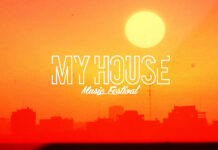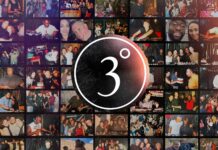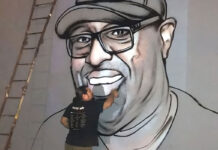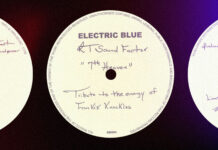Beyond Heaven is a series of books that serve as one of the best historical references to the early days of Chicago House Music that we have. Collecting flyers dating back as far as 1981, the books are stuffed with the names of DJ both prominent and obscure and forgotten, and venues that no longer exist outside of a lot and a street address.
Chicago isn’t the best at preserving its history. We tend to grind it up — like melting down old vinyl to make new records that sound worse than the originals. Landmarks in blues, jazz and house history that are as important as the birthplace of Beethoven are now parking lots or anonymous waystations on an Amazon distribution chain. Papers and documents that wind up in the hands of archivists and academics are preserved for the future, but at the cost of accessibility: something that belonged to the street is preserved under glass in places where you must make an appointment just to look at it. It’s just moving from one closet to another. It suffocates.
In Chicago we called our flyers “pluggers.” Maybe some other cities did that too — slang rarely stops at the city limits — but up until just a few years ago that was still a term you heard from printers and promoters when making or taking one for a show. The plugger was made for the street, for being pasted under Chicago’s orange streetlights, slipped under windshield wipers or secreted into rival clubs, high schools and anywhere else the party people might be.
Beyond Heaven takes these artifacts of the street and puts them back on the street — or at least closer in proximity than they’ve been in years. Published as a series of small books that almost anyone can afford, Beyond Heaven is the brainchild of DJ and collector Mario “Liv It Up” Luna and publisher Brandon Johnson of Almighty & Insane Books. You’ve heard of “page turners.” Luna and Johnson have created three books that people simply cannot put down. With minimal explanatory text, the reader plunges into this world — the early days of a new music genre and the rudiments of a culture that was growing around it. Beyond Heaven is also a visual illustration of how a culture grows — the process of house music rolling out of the clubs and into the neighborhoods.
No matter how well you think you know it all, you don’t know it all. Beyond Heaven brings long-forgotten and sometimes tragic figures back into the spotlight along with the party crews, promoters and venues that left little but memories and old pluggers behind. I was fascinated to see one flyer promoting a lady’s night — a “Battle of the Lady DJs” with nine names and faces of women who must be considered pioneers, but none of whom I’d ever heard of before and won’t be found in any archived Red Bull lecture or academic study of the scene’s early years.
These are the scattered primary documents of a movement that has changed popular culture worldwide, from Logan Square to Tokyo. This is the story of the people who put them back together again.

Some people speak in entire paragraphs. Mario “Liv It Up” Luna speaks in whole stories. We talked for about 90 minutes and I think I asked five or six questions altogether, most of those bunched up at the end.
Luna is a born collector, if you think such people are born rather than made. For his whole life he’s been collecting records, cards, flyers and most importantly stories. He has a flair for incredible detail, recounting not just people but adding where they lived and even the nearest street corner. He must be a lawyer, I thought, because his way of talking reminds me of a lot of legal depositions I’ve read in which attorneys create a seamless barricade of facts without any gap between them. Later I learn that he’s not an aspiring prosecutor — Mario remembers addresses so well because he delivers the mail.
Luna was born in Chicago and raised in Pilsen. “Back then it was rough, bro,” he says. “Back then it was a lot of gangs. It’s still a little hairy, though right now as gentrification has come in, a lot of yuppies have moved into the neighborhood.
“I grew up on Damen and 18th Street. You had one big gang from around Western to Ashland. Going east, past Ashland it was like The Warriors, that old school movie. If you had to go through different neighborhoods, then you better know some people in gangs because they’d be out there.”
Already a DJ, Luna used to carry a mixtape around and says, without exaggeration, that being a DJ probably saved his life.
“I always had a mixtape on me. I made them on cassettes in my basement — I was a ‘basement DJ,’ I guess. I used to make my mixes on a 90 minute Maxell or TDK tape and have that in my back pocket. Whenever they came up to me — ‘Whatcha be about?’ I’d say here: this is what I’m about. This is me, Mario ‘Liv It Up’ Luna and I’m a DJ.

Don't Stay In 💌
Get on our guest list for news from 5 Mag and you'll never miss a thing. It's free and we don't sell your shit.
“Now my grandma lived on Blue Island and 18th Street, and that was a whole different story. You had the Party People, the Ambrose, the Latin Counts — every block was a different section. You better not wear the wrong colors passing through because they’d beat your ass with a bat. Me, I just got on the 10 speed to visit my grandma and grandpa and hand out cassette tapes to the people. A couple of times that shit saved my life.”
This early exposure to Chicago gangs and what the Guardian has dubbed their “strange graphic design subculture” lead to one of Mario’s more unusual collections and, eventually, to meeting his publisher. It was sort of like the gangs’ equivalent of paper flyers then circulating in the house music scene — a way to get your name out there in an analog world.
“Growing up in the ’70s, you would see the gangs trying to promote themselves,” Mario says. “They can’t make flyers, so they made business cards. They were called ‘compliment cards.’ I saw them outside my grade school passing them out. And you know what, they looked dope! The colors, the Old English lettering, the fonts, the raised printing that you could feel.”
Mario started collecting them, “like baseball cards. We all did. You’d have a nice little stack of compliment cards and you put it away and you don’t think nothin’ about it. In high school, it was the same thing — you collect ’em, put them in a shoebox and you don’t think nothin’ about it. The next thing you know I had like a hundred of them in my mom’s basement.”

Decades later, Mario saw a guy on eBay selling a compliment card for $20. He knew people collected them back in the day, like he did. “But I was like, wait… people are buying this shit now?” He met up with the seller, an ex-member of the Gaylords, one of Chicago’s oldest gangs. “He said he was looking for more Southside cards. I told him I had some from when I grew up in Pilsen and he got all excited.”
It was a new field for collectors — something totally new and unheard of and which some people would find a little shocking. Mario soon took out an ad on Craigslist to try to find more.
“I started buying collections for anywhere from $400 to $2000,” he says. “”Next thing you know I had a massive compliment card collection. But being a mailman in Humboldt Park I had more connections. I’m over by Western Avenue, over by Roberto Clemente High School, by the Puerto Rican flag. I’m talking to those guys and they used to give me their cards, I’m getting sweaters and patches. I was getting heavy into it but I was a collector — that’s it, just a collector.”
‘There’s always a story connected to these flyers. Something happened, there was some connection made through these parties.’
As interest in the cards grew, prices began to increase. But being a guy paying cash for gang memorabilia carried significant risks. Some of the people selling their collections were born-again Christians who left the life behind. A few of them were probably not.
Mario describes buying his last collection in sketchy circumstances. “I’m at a flea market, the Swap-O-Rama in Cicero,” he says. “I met up with some guys. One of the guys in the car kept looking at me. You know, not just looking, but that look. The questions started getting a little stronger from these guys. Like, ‘Dude, what do you want these cards for?’ Sometimes they don’t go for that ‘I’m just a collector’ line. ‘No,’ they ask, ‘really — what are you doing with them?'”
Luna had avoided gang violence by handing out mixtapes. Now he risked getting “stabbed or shot” trying to buy gang cards from what could have been the same people. After his daughter was born and at his wife’s urging, Mario began to dismantle his collection. “I just started selling them bro. Let me just quit while I’m ahead.”
He’d started selling cards online to other collectors years earlier. “I had a big enough collection that I could sell off duplicates or whatever on eBay. That’s how I met Brandon.”
Brandon was one of the collectors on the other side of those online trades. “Mario was selling compliment cards on eBay from a big album he had back then,” he says. “Lots of rare and high quality cards from the Southside. Being a collector this type of thing I couldn’t pass them up. Eventually our first book, Thee Almighty & Insane: Chicago Gang Business Cards from the 1970s and 1980s came out.”
“I knew he lived in New York but that’s it,” Mario says. “I used to sell him cards here and there — I sold him some pretty dope cards, actually. Next thing you know the book came out and it’s in the Chicago Reader! I’m like ‘Hey man, did you make a book with my cards?!’ He’s like yeah, and I’m like ‘Oh! Cool!'”
After selling off his compliment card collection, Mario asked himself “What next?” He remembered the house music pluggers at his mom’s house and started putting them in order. He put out an ad seeking more. The clientele was a bit different than the last time he was putting money on the street to buy collections. “Actually it was a lot of girls that had these flyers in a shoebox in their closet,” he says.
Brandon was in town and met up with Mario at a pool hall on Montrose. “I brought one of my binders to the meeting,” Mario says. “It was a Saturday night, it’s snowing outside and we’re just drinking beers. He’s flipping through them and his eyes are wide open. Like ‘Wow, Jamie Principle! Wow, this guy, that guy… Would you want to do a book?’ I said why not, let’s do it.”
Brandon was born in 1985, and has mostly lived through the era of Chicago house music’s origins vicariously “through the music and stories I’ve heard from those who were around back then. But, as a historian, that’s nearly as good!”

Moving from a book of gang business cards to house party flyers “felt like a perfect follow up” to Brandon — moving from “the light to the dark. Although that’s way too simplified given how deeply ingrained and interconnected the cultures in Chicago were at the time.” Luna’s collection was “a treasure trove of important history and it was both an opportunity and challenge to put something into the world that did the material justice. And in the process Mario and I became good friends.”
Luna began collecting flyers back in the day “nonchalantly. I’m just collecting and next thing you know I have a collection of gang sweaters, gang cards and now flyers.” Like everyone else, he used to grab a handful at the record shops. “I went to school downtown and had a little part time job at the American Dental Association, right across from Water Tower. I worked in the mailroom. Yeah, I’m a mailman, and used to work in the mailroom as a kid, right?
“I used to walk all the way down Michigan Avenue, and maybe that’s how I got used to walking on my route, but I used to walk all the way down to Importes and Loop Records downtown. After buying my records they had all these flyers on the shelf, I’d throw them with my records in my record bag. At home I’d put the flyers to the side and spin. I didn’t realize I was building some kind of massive collection.
“People are like, ‘You saved this? What made you save this?’ Well, not all of it! And I almost lost it all because my mom was gonna throw this stuff out. I’m delivering the mail one day and my brother calls me and says, ‘Hey man, mom’s gonna toss all your shit out because she’s been telling you to get it out of her basement!’ It’s raining, like in April, I’m delivering the mail on Division and Western. I get the call that mom’s about throw all my shit — all my flyers, sweaters, all of it! — right in the trash. She had everything ready for the trash but I managed to get it all before she did.”
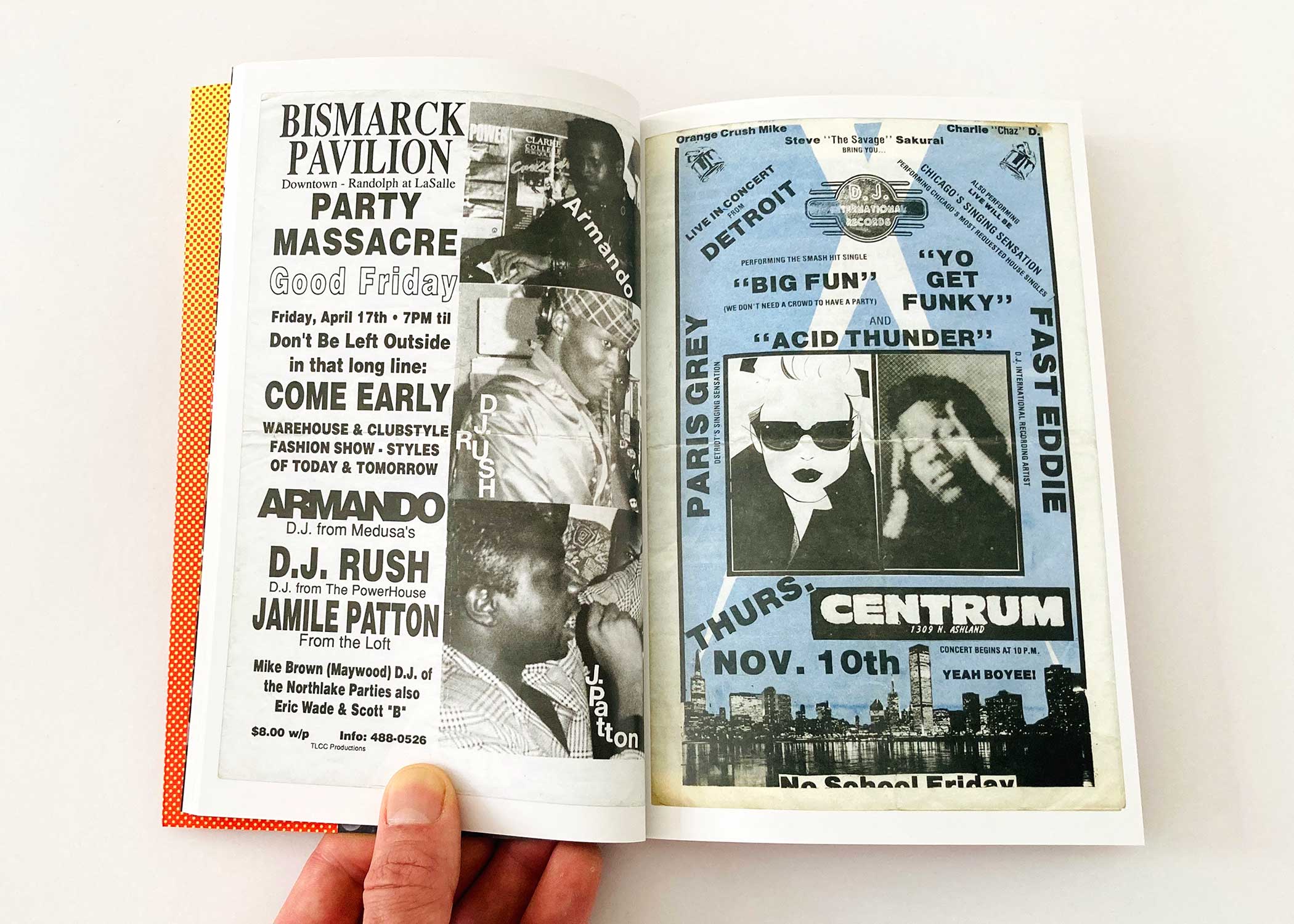
Mario’s collection at the time was 600 or 700 pieces which they had to cull for a 96 page book. Mario and Brandon picked out ones “with colors, or interesting illustrations.” But what sold the book, Mario says, was “the Westside parties with Ron Hardy, Frankie Knuckles and Lil Louis. Those have to be in there for people to buy the book. I said let’s make sure we have these guys in there.”
But many were sold by a more personal connection. “People were like ‘Wow, I’m on a flyer!'” Mario says. “Or ‘This one is where I met my wife at the Rainbo or the Aragon.’ Or ‘There was a fight outside.’ There’s always a story connected to these flyers. Something happened, there was some connection made through these parties.”
But one of the best parts about Beyond Heaven is that it’s as accurate a representation as we’re going to get of what was actually being played and who was playing them back in the day. Nobody can, or will, or even wants to denigrate the role of Frankie, Ron, Louis, Farley, Marshall, Steve and Pierre in the early days of Chicago house music history. But the flyers are a suggestion of a huge scene, parties popping off in every neighborhood every weekend. It casts a light on a lot of artists and DJs and impresarios that the “one sentence summary” of house music history which has proliferated (especially post-Beyoncé) leave out of the picture.
Casting a light on these neglected pioneers and heroes of the underground is one of Brandon’s favorite aspects of Beyond Heaven. “I’d hope that making this information available encourages others to dig back deeper into the music and find hidden gems or at least artists/DJs they appreciate that were previously unknown to them,” he says.
I mention this to Mario, and in particular some DJs who appear frequently on old flyers like Mark Imperial and Mike “Hitman” Wilson. Some of these guys even had pretty massive recording careers — Wilson went from remixing Inner City’s “Good Life” to New Order and Prince. He made solid acid remixes, top 40 commercial club records and his name is all over these flyers but he and artists like him rarely get the shine they deserve.
“You know, that’s right,” he says. “I actually used to like recording Mike’s mixes because he’d do his own remix of a song on reel-to-reel that was never pressed on wax. Too bad I don’t have those cassettes — I used to lend them out to people. His shit was dope, man. What you used to do is record the mix and take it to the record store and play it for them to ID tracks. I used to take the cassettes down to Importes and ask if they knew what it was and if they had it and they’d be like ‘No, that’s Mike Hitman’s mix, that’s never going to be on wax.’ It was something unique and exclusive.”
It’s another area of history exposed by these flyers — the fact that many of the biggest tracks in the club were never released. Some have done the work to piece together tracklistings from live mixes back in the day, though again these mainly focus on mixes from Ron Hardy, Frankie Knuckles & Co. Beyond Heaven publishes playlists from Importes, Etc and Loop Records for what Brandon calls “cross-sections of what songs were hot at the time.”
“Kenny Jason played his own exclusives too,” Mario says. “He would use his synthesizer, his keyboard with a beat track and I was like is that a record or is that him playing that? Ralphi Rosario would play some obscure Italo Disco that nobody else played. I used to like Ralphi’s style too. It was smooth, nice blends and you wouldn’t know if it was one record playing or two. But a lot of the stuff he played, he was the only guy who had it. I remember one song called ‘Pineapples’ by Come On Closer and this shit was so hard to get. It’s still hard to get, even though they’ve repressed it so many times. He used to play the hell out of it and it was impossible to get it.”
This is how culture was made for decades, even centuries, and maybe it explains why music culture today — lacking this local ownership, growth and stimulation by the participants themselves — is mostly cycling through retro styles over and over again.
Stepping back and taking the bird’s eye view, the greatest takeaway from Beyond Heaven is that these flyers form a record of the way that culture used to be made. You see big house events — huge by anything but modern festival standards — and then the music spreading through the schools and neighborhoods where individual DJs, promoters, party crews, etc. had some sense of ownership for the culture they loved and were helping to create. House was going on in Chicago for awhile before anyone with big money really picked up on it. The record industry (then in the process of consolidating in Los Angeles) really had no fucking clue what was happening here, and even less what to do with it when they got wise.
This is how culture was made for decades, even centuries, and maybe it explains why music culture today — lacking this local ownership, growth and stimulation by the participants themselves — is mostly cycling through retro styles over and over again.
What Brandon calls the “ground-up, localized” way that house music in Chicago developed is apparent in the flyers, he says — especially considering how many were handmade and drawn freehand, promoting events at local neighborhood joints. “My understanding is that the sound developed in the clubs (such as the Warehouse) by DJs (such as Frankie Knuckles & Ron Hardy) and then individuals (such as the Chosen Few) who found their way into the clubs went on to release some of the first examples of what we consider to be house music on their own labels,” he says. “Importes, Etc and Loop Records created sections for this newly-developed category from which other DJs pulled for their sets. Eventually the WBMX Hot Mix 5 brought the sound to Chicagoland’s masses over the radio waves. Not until later did the bigger labels catch on! Of course many of the artists were on the short end of bad record deals both with local labels and bigger national/international labels. But that’s another story altogether.
“Circling back, the local quality of the culture is something that feels different than the culture of today where any type of music from across the world and any era is available literally at the tips of your fingers which I think has changed the way culture has developed from say the 1980s.”

There are three volumes of Beyond Heaven, the third having been released in October. Sharp eyes will have noted a certain aesthetic design that became apparent when the series was complete. “If you notice the covers it’s kind of symbolic how we did it,” Mario says. “The first one is like a sunrise. It’s pink, blue, and it’s like the sun is coming up over the lake. The second is sundown: it’s orange, like the sun is going down over the city. And the third one is dark, it’s nighttime. Put them all together — 1, 2, 3 — sun up, sundown and nighttime.”
The third volume is, for now, the last. Mario attributes that decision to Brandon, who says that a trilogy “just feels right. We didn’t intend to make multiple volumes from the outset, but after the first one came out Mario managed to expand his collection with some really good stuff so we had to do a second. Repeat that for the third. In the end things need to be limited in some way and in an ideal world everything would have been in one book, but that’s just not how the cookie crumbled. Although we wouldn’t necessarily have done it differently if given the chance. With that said, we’ll consider reprinting any of the volumes if there is demand. Mario is always telling me people keep hearing about the books for the first time. If the people want it, we will provide.”
Acquiring new source material might not be as easy in the future either. “Now nobody wants to sell me their shit,” Mario says. “People used to call and tell me when they came across a bunch of flyers. I approach them now and they say, ‘Nah, I think I’m gonna keep ’em.’ They see the success and they want to hold on to them.”
The appeal of the series has been self-evident. But why? For some people, Mario tells me, these are just pieces of paper, reprinted on new pieces of paper. For other people, it’s history, though. And it’s their history, from a time when people still felt like they were in control of it. Like Mario said: There’s always a story connected to these flyers. Including his own.
“You know, I might think weird,” he tells me. “I might be different, but we’re all on this planet for a little while and then we check out. Right? So you’re going leave a legacy somehow. For me, I never made it as a Bad Boy Bill or a Cajmere. But I do have a book. Someday when I pass away someone will have this with my autograph in it, and they’ll say ‘Mario? Yeah, I have that book from him.'”
There’s more inside 5 Mag’s member’s section — get first access to each issue for a few bucks a month.






